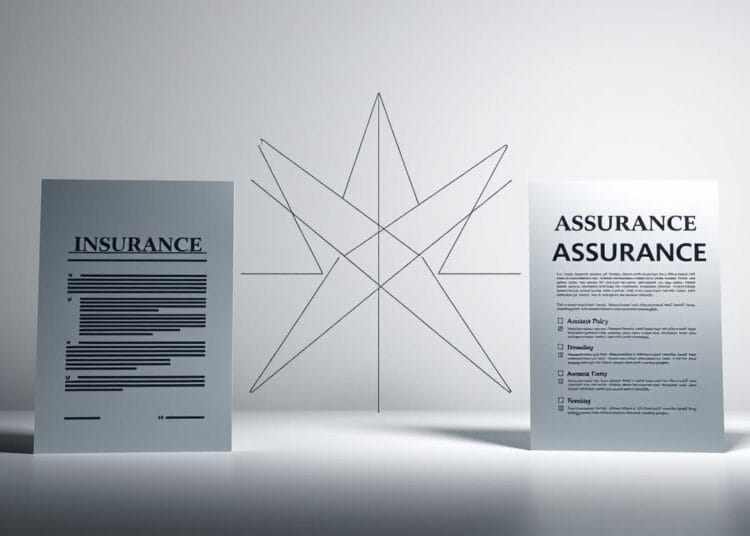7 Key Differences Between Insurance and Assurance
Choosing between insurance and assurance can be tricky. This article breaks down the 7 big differences. You’ll learn how these products work and why their structures matter. Plus, how to avoid common misunderstandings.
Your financial future depends on making the right choices. These products serve different purposes. This guide helps you understand the difference between insurance and assurance. It ensures you pick the right option for your needs.
Key Takeaways
- Understand the 7 key distinctions shaping your financial protection strategy.
- Learn why assurance offers fixed payouts while insurance covers variable risks.
- Discover how tax rules and payment schedules differ between both options.
- Clarify long-term goals through tailored explanations of insurance vs assurance.
- Get actionable steps to evaluate which product aligns with your life stage.
Understanding the Fundamentals of Financial Protection
Insurance and assurance are key to protecting us from life’s surprises. Let’s explore their history and how they help you.
The Evolution of Risk Management Products
| Time Period | Risk Management Tools |
|---|---|
| Pre-18th Century | Mutual aid societies and communal support systems |
| 18th Century | Early life insurance policies in London |
| Modern Era | Digital platforms for comparing insurance and assurance |
Why These Financial Safeguards Matter to You
- They protect your savings from sudden events like accidents or market changes
- They help keep things stable during health crises or when you lose income
Common Misconceptions About Protection Products
“All policies work the same way.” This is not true. Insurance and assurance have big differences in how they pay out and what they guarantee. Another myth is that assurance is just another word for insurance. But assurance often means guaranteed payments under certain conditions.
What Exactly Is Insurance? A Comprehensive Definition
Insurance is a financial tool that protects you from unexpected losses. It’s different from assurance because it doesn’t guarantee payouts. Instead, it’s based on sharing risks.
You pay premiums to an insurer who manages a pool of money. If something unexpected happens, like a car accident, the insurer helps you from that pool. This way, many people share the risk, making it more affordable for everyone.
- Life Insurance: Covers death benefits for beneficiaries.
- Health Insurance: Shields you from medical costs during illness or injury.
- Property Insurance: Protects homes or vehicles from theft or damage.
- Casualty Insurance: Addresses liability in accidents or legal disputes.
| Type | Example Scenario | Coverage Focus |
|---|---|---|
| Life Insurance | Family receives funds after policyholder’s death. | Income replacement for dependents. |
| Health Insurance | Hospital bills after a surgical procedure. | Medical expenses and treatments. |
| Property Insurance | Roof repair after a storm damaging your home. | Physical asset restoration. |
| Casualty Insurance | Legal fees after a car accident lawsuit. | Liability protection and compensation. |
Premiums are based on how much risk you pose. For example, a driver with no accidents pays less for insurance than one with accidents. Insurance contracts also outline what’s covered and what’s not. Knowing these basics helps understand the differences between insurance assurance discrepancies, which we’ll dive into later.
Defining Assurance: More Than Just Another Term for Insurance
Understanding the differences between insurance vs assurance starts with their origins. Assurance isn’t just another word—it’s a special financial tool shaped by centuries of evolution. By looking into its history and purpose, you’ll see how it’s different from traditional insurance.
“Assurance emerged to address life’s certainties, while insurance manages its uncertainties,” explained financial historian Dr. James Monroe.
The Historical Development of Assurance Products
Assurance started in the 1700s with early life contracts that focused on mortality. Unlike insurance, which deals with unpredictable events, these early policies guaranteed payouts upon death. Key milestones include:
- 18th-century London: First life assurance companies formed to provide death benefits
- 19th-century expansions into retirement savings and estate planning
- Modern hybrid products combining savings and risk protection
How Assurance Became Distinct in the Financial Industry
Assurance’s uniqueness comes from its contractual guarantees. Unlike insurance, which pools risks probabilistically, assurance products often promise payouts under agreed terms. These insurance assurance variances create structural differences:
- Guaranteed payouts vs. probabilistic insurance claims
- Long-term commitments (e.g., whole life policies) vs short-term coverage
- Contractual obligations vs risk-based underwriting
Recognizing these contrasts shows why assurance is a standalone category. This clarity is important when comparing options in the insurance vs assurance debate.
The 7 Big Differences Between Insurance and Assurance You Need to Know
Choosing the right financial product is key. Understanding the key contrasts insurance assurance brings is essential. These seven differences help protect your assets, plan for the future, and manage costs. Let’s break down each difference to help you avoid costly errors.
Difference #1: Risk Coverage Approach
Insurance protects against unknown risks, like car accidents or home fires. Assurance, such as permanent life policies, focuses on predictable events like aging or planning for inheritance. This shows their main purposes.
Difference #2: Duration of Coverage
Insurance usually ends after a certain time (e.g., 10-year disability policies). Assurance, on the other hand, lasts until you reach a certain age or pass away, providing lifelong protection.
Difference #3: Premium Structure and Payments
Insurance premiums can increase over time. Assurance often has fixed rates, making it easier to budget for long-term plans.
Difference #4: Payout Guarantees
Insurance payouts depend on certain events happening. Assurance guarantees payouts at a set time, like when you retire or the policy ends.
Difference #5: Investment Component Variations
Some assurance products grow in value. Most insurance focuses on risk protection without the chance for growth.
Difference #6: Tax Implications for You
Taxes can differ: premiums in life assurance might be deductible in some states. But, insurance types are taxed differently.
Difference #7: Beneficiary Considerations
Insurance payouts go to beneficiaries only if claims are valid. Assurance guarantees payouts to heirs, no matter the event.
The Time Factor: How Duration Sets These Products Apart
Time is key when looking at insurance assurance distinctions. Insurance policies have set terms, like 10, 20, or 30 years. You need to renew or replace them when the time is up. Assurance products, like whole life policies, cover you for life if you keep paying premiums. This difference affects how you plan for your financial future.
Here’s a quick insurance assurance comparison based on time-related factors:
- Term Limits: Insurance ends when its term is over unless you renew it. Assurance stays active until you pass away or the policy matures.
- Age Impact: Renewing insurance later in life can increase premiums. Assurance premiums stay the same, no matter your age.
- Maturity vs. Expiration: Assurance builds cash value over time. Insurance pays out only during its active term.
Choosing between insurance and assurance depends on your needs. For example, a 20-year term policy might be enough until your kids graduate. Assurance is better for lifelong coverage. Remember, insurance premiums go up when you renew, while assurance payments stay the same over time.
“Time is money—when it comes to policy terms. Matching coverage duration to your life stage avoids gaps or overspending.”
Understanding these time-based differences helps you choose the right product for your financial plan. This ensures your protection grows with your needs.
Financial Implications: How Premiums and Payments Differ
Choosing between insurance and assurance means looking at costs. Insurance assurance variances come from their basic differences. Let’s explore the financial side.
Premium Calculation Methods Compared
| Type | Insurance | Assurance |
|---|---|---|
| Premium Basis | Current health/age at purchase | Long-term mortality tables + investment returns |
| Adjustments Over Time | May increase with age or claims history | Rarely changes once policy is issued |
For instance, two 30-year-olds with the same health might pay $120/month for term life insurance. But, they could pay $250/month for whole life assurance. This is because whole life includes savings.
Payment Structures and Budget Impact
- Insurance often offers flexible payment schedules (monthly, quarterly)
- Assurance may require larger annual premiums or single lump-sum payments
- Some assurance policies allow premium holidays after a set period
Choosing monthly payments in insurance vs assurance explained guides your budget. Insurance might be more affordable at first.
When Payments End
Term life insurance payments stop when the policy ends (e.g., 20-year term). Assurance premiums keep going for life, but some policies can become “paid-up” after 10-15 years. This shows big differences in long-term costs.
“The payment timeline directly impacts your financial strategy,” says financial advisor Sarah Chen of Wealth Horizon Advisors. “Clarify whether you prefer short-term flexibility or long-term stability.”
Risk Assessment: How Providers Evaluate You Differently
When you choose between insurance and assurance, it’s key to know how providers look at your risks. These insurance assurance discrepancies affect what you can get, how much it costs, and what’s covered. Each model has its own way of looking at things.
Medical Examinations and Their Significance
Medical exams are very important in the underwriting process. For insurance like life or health plans, exams might check your immediate health. But, assurance products, like permanent life policies, need a deeper look to guess long-term risks. What you get back depends on these results.
| Factor | Insurance Approach | Assurance Approach |
|---|---|---|
| Medical Exam Frequency | Required for high-value policies | Regular re-evaluations |
| Tests Conducted | Bloodwork, vital signs | Genetic history, chronic condition analysis |
| Premium Impact | Short-term rate adjustments | Long-term cost tiers |
Lifestyle Factors That Affect Your Eligibility
Things like smoking, dangerous jobs, or extreme sports can make a big difference.
“Lifestyle risks are quantified differently—insurance reacts to immediate threats, while assurance prioritizes lifetime risk probabilities,”
explains a certified underwriter. Here’s how they compare:
- Insurance: Looks at dangers right now (e.g., risky jobs)
- Assurance: Checks habits that might affect your life span (e.g., being overweight)
These checks make sure you fit what the product is for. Knowing these differences helps you guess how you’ll do and choose wisely.
Investment Components: Where Your Money Goes in Each Product
When looking at insurance vs assurance, the investment parts show a big difference. Insurance, like term life or auto coverage, doesn’t invest your money. It just pays claims when you need it. Assurance, like whole life or universal life policies, splits your money into three parts: costs, investments, and fees.
- Coverage component: Funds ensuring protection against risks (e.g., death or disability)
- Investment portion: Money allocated to grow over time in assurance policies
- Administrative fees: Costs for managing the policy
Assurance investments grow your money over time. They use strategies like guaranteed interest rates or market-linked sub-accounts. This way, your cash value grows tax-deferred, helping with long-term savings. Unlike insurance, which ends when coverage does, assurance’s cash value stays with you even if you stop paying premiums.
When choosing between these products, ask: “Do I want pure risk protection (insurance) or a mix of coverage and growth (assurance)?” Knowing how your money is used helps match your choice with your financial goals. This could be for retirement savings or estate planning.
Making the Right Choice: Which Option Suits Your Needs
Choosing between insurance and assurance depends on your situation. Let’s look at how life stages, goals, and advice help pick the best option for you.
Life Stage Considerations for Your Selection
At different times in life, what’s important changes. For instance:
- Young professionals often choose insurance for immediate needs like health.
- New parents usually go for assurance for long-term family security, as insurance assurance comparison suggests.
- Those nearing retirement might pick both for both protection and saving.
Financial Goals That Align with Each Product
Match your goals with the product’s features:
- Insurance is good for short-term needs (like auto insurance) and insurance vs assurance explained shows its purpose.
- Assurance fits long-term plans like estate planning or saving for retirement.
Working with Financial Advisors to Determine Your Best Fit
Find advisors who clearly explain the trade-offs. Ask them:
- “How does this fit with my timeline and goals?”
- “What are the tax implications?”
“The right choice isn’t about labels—it’s about matching your needs,” says financial planner Sarah Thompson.
The insurance assurance comparison isn’t about picking a “winner.” It’s about choosing the right tools for your life’s journey.
Common Mistakes to Avoid When Selecting Between Insurance and Assurance
Choosing between insurance and assurance without knowing the 7 big differences between insurance and assurance can lead to bad decisions. Many people make mistakes by picking products based only on price or ignoring long-term effects. Here’s how to avoid common errors:
- Prioritizing cost over coverage: Focusing only on monthly premiums can be a mistake. First, compare policy details, then look at the price.
- Using assurance for short-term goals: Assurance is for long-term goals like retirement or estate planning. For short-term needs, choose insurance that covers specific risks.
- Ignoring product specifics: Not checking terms like payout triggers or eligibility criteria can lead to wrong coverage. Make sure it fits your situation.
- Underinsuring to save money: Cutting coverage limits to save money might not be enough for big life events. Find a balance between cost and protection.
- Skipping regular reviews: Life changes like marriage or career shifts mean you need to update your coverage. Review policies every year to match your current needs.
- Overlooking fine print: Exclusions, waiting periods, or rules for beneficiaries in policy documents can cancel claims. Ask providers to explain unclear terms.
- Choosing based on sales pitches: Don’t rush into buying complex products without checking if they meet your unique risks and goals.
These mistakes come from not understanding insurance assurance discrepancies. Take time to learn about the 7 big differences between insurance and assurance. This way, you can make informed choices for your financial future, not quick fixes.
How to Build a Comprehensive Financial Protection Strategy
Creating a solid financial plan means knowing about insurance assurance variances and insurance assurance distinctions. First, figure out what you need now, what you want in the future, and how much risk you can take. This guide will help you mix products and keep your strategy up to date.
Combining Different Products for Optimal Coverage
Good strategies use insurance assurance distinctions to cover all bases. Mix short-term and long-term options:
- Term life insurance for temporary high coverage
- Permanent assurance policies for legacy planning
- Health insurance to cover unexpected medical costs
Periodic Review Guidelines for Your Protection Portfolio
Keep your plan fresh by updating it regularly. Here’s how:
| Review Trigger | Action Steps |
|---|---|
| New job or income change | Adjust coverage amounts |
| Policy renewal dates | Compare options for better terms |
| Family changes (marriage, children) | Update beneficiaries and coverage types |
Use insurance assurance variances to balance your portfolio. Set up annual reviews or mark policy anniversaries as reminders. A good plan combines different types of insurance to meet changing needs.
Conclusion: Securing Your Financial Future with Informed Decisions
Knowing the difference between insurance vs assurance is vital for a strong financial plan. We’ve looked at the insurance assurance comparison in seven important areas. These include coverage types and tax impacts. Your specific needs decide which one fits your plan better.
Insurance usually covers unexpected events like accidents or illnesses. Assurance, on the other hand, guarantees payouts at specific times. Both protect your assets and future. But, picking the right mix depends on what you value most.
Financial security is an ongoing journey, not a one-time choice. Use what you’ve learned from this insurance assurance comparison to see how each fits your budget and goals. By focusing on clarity, you can avoid costly errors and build a safety net that grows with you.
Begin by checking your current policies. Ask if they match your current risks and if you’re using tax benefits well. With this information, you can make choices that safeguard your assets now and secure your family’s future. A well-thought-out plan turns uncertainty into stability, giving you peace of mind at every life stage.
FAQ
What is the primary difference between insurance and assurance?
Insurance covers uncertain events like accidents or illnesses. Assurance protects against certain events, like death or policy maturity.
How do premiums differ between insurance and assurance products?
Insurance premiums change based on risk and can vary. Assurance premiums stay the same and are based on life expectancy.
Do insurance and assurance cover the same risks?
No, they don’t. Insurance is for unpredictable events. Assurance is for inevitable ones, like death.
Can I choose my premium payment schedule for both insurance and assurance?
Yes, you can. Both offer flexible payment plans like monthly or annually. But, options vary by product.
Are there tax implications associated with insurance and assurance?
Yes, there are. Insurance payouts might not be taxed. Assurance’s tax rules depend on its investment parts.
How does the duration of coverage differ between these two?
Insurance covers a set term, like 10 or 20 years. Assurance covers your whole life, as long as you pay premiums.
What factors affect eligibility for insurance versus assurance?
Insurance looks at your current health and lifestyle. Assurance considers your long-term mortality risk.
How does the investment component work in assurance compared to insurance?
Assurance has an investment part, building cash value. Most insurance, like term life, focuses on risk management without savings.
What common mistakes should I avoid when choosing between insurance and assurance?
Avoid picking based only on price. Don’t ignore your personal needs. And, review your coverage as your life changes.
How can I make an informed choice between insurance and assurance?
Think about your life stage, financial goals, and needs. Talking to a financial advisor can help you choose wisely.









